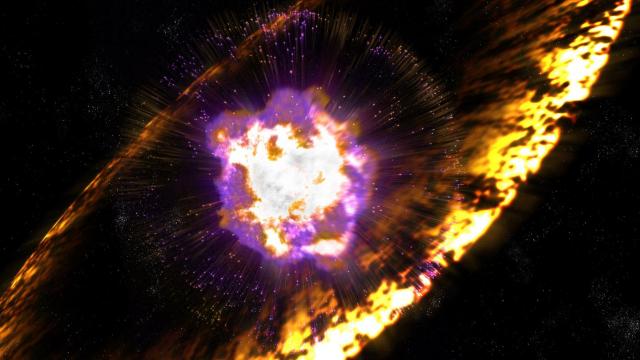Several million years ago, a series of nearby supernovae explosions lit up the sky, rained radioactive particles down on our planet and might have kickstarted a major climactic shift. That’s according to a pair of studies published today in Nature, which link radioactive debris spread across the seafloor to cosmic fireworks hundreds of light years away.
Astronomers have long speculated that nearby supernovae — stellar explosions that occur when a star runs out of fuel and collapses — have impacted our planet throughout geologic history. Indeed, we’ve even determined a “kill distance”, wherein the high-energy particles released by such an explosion would be catastrophic to life on Earth. (In case you were wondering, it’s 26 light years.)
Now, in one of the most detailed analyses to date, an international team of researchers has shown that not-too-distant supernovae have affected the Earth in the not-too-distant past.
The first hints came over a decade ago, when a research team at TU Munich discovered evidence of iron-60 in geologic samples collected on the Pacific seafloor. A radioactive isotope that decays with a half-life of 2.6 million years, iron-60 is produced abundantly in stellar explosions. Intrigued by the find, Anton Wallner from The Australian National University assembled an international team to scour the seafloor for additional evidence of stellar entrails.
From 120 samples collected across the Pacific, Atlantic and Indian Ocean floors, the team discovered that the radioactive fallout is globally distributed. Furthermore, it can be traced to two separate time periods: 6.5-8.7 million years ago, and 3.2-1.7 million years ago. “This is by far the biggest such study that’s ever been done,” astronomer Adrian Mellott of the University of Kansas, who was not involved with the study, told Gizmodo. “It tells us pretty definitely that this happened, and it could hardly be anything but supernovae.”
The more recent of the two events overlaps with the onset of a major global cooling episode — the Pleistocene. Mellott and other astronomers suspect that nearby supernovae can affect Earth’s climate in a number of ways, most importantly by burning up our ozone layer. Whether the death throes of a star helped kickstart the Pleistocene isn’t clear, but it’s certainly an intriguing possibility. “We don’t have any concrete evidence that any one event is tied to a supernovae,” Mellott said. “But the odds are, one or more are.”
As for where exactly the cosmic eruptions originated? A second study out in Nature today attempted to answer that exact question, by modelling iron-60 transport through interstellar space. The study found that the nearest of the explosions probably occurred in an ageing star cluster some 326 light years away.
While that’s not exactly our cosmic backyard, it’s close enough to have left an impression. If you were alive on Earth a few million years ago, a deep blue object, small as star but bright as the Moon, would have made a dazzling addition to your night sky.
Top: Model of iron-60 expelled into our cosmic neighbourhood by a recent series of supernovae eruptions. Image: Michael Schulreich
